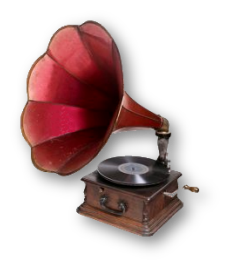
The Internet's Premier Classical Music Source
Related Links
Recommended Links
Site News
Historical Recordings

"Greetings to Dr. Edison. I am Dr. Brahms – Johannes Brahms!" Thomas Edison's astounding invention, the phonograph, was a mere twelve years old in 1889 when the greatest composer of the time shouted those words into a large horn and then launched into a vigorous performance of his First Hungarian Dance. The crude cylinders used at that time eventually gave way to Emile Berliner's revolutionary flat disc, but the large and cumbersome acoustic horn remained state-of-the-art for several decades to come. While this primitive device was adequate for recording the tenor voice (particularly Caruso and his friend John McCormack), other voice ranges, non-brass instruments, and orchestras fared considerably less well.
Despite its limitations, a steady stream of great composer/performers eventually made acoustic recordings, including Edvard Grieg, Camille Saint-Saëns, Claude Debussy, and George Enescu. And while that precious Johannes Brahms cylinder quickly deteriorated to the point where the music became barely audible, we can still enjoy the recordings of some of his closest musical friends, such as pianist Ilona Eibenschütz or the legendary violinist Joseph Joachim. Some considerable patience and imagination is required to appreciate the noisy, attenuated, and tinny sounds of these antique discs. But they can also be extremely rewarding and provide us with a unique insight into the composer's own thoughts on how their music ought to go.
The horn was eventually replaced by an electronic recording process in 1924, an innovation which at last made it possible to reproduce the sound of a full orchestra with reasonable fidelity – and to hear the subtle nuances of solo and chamber performances. Still, only four and one-half minutes of music could be recorded on each side of a 12-inch, 78-rpm disc. Symphonies and other extended works had to be broken up into short sections, and performers had to be extremely careful to match the tempo and dynamics at the end of each portion of the work to the beginning of the next side. A missed note or unbalanced chord could not be easily corrected – the entire side had to be re-recorded. The prevailing philosophy of early recording producers was "get it right the first time or forget it." Despite (or perhaps because of) these highly unfavorable conditions, a very large quantity of unforgettable recordings were made. ~Tom Godell













